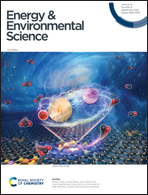A facile strategy for third-component selection in non-fullerene acceptor-based ternary organic solar cells†
Abstract
The ternary strategy has been proved to be an efficient approach to improve the power conversion efficiency (PCE) of organic solar cells (OSCs). However, little attention has been paid to deriving the general design principle for selecting an appropriate third component. Herein, we proposed a facile strategy for third-component selection in non-fullerene acceptor-based ternary OSCs. By sharing the same central unit with the host acceptor and a single fluorinated end group, the designed non-fullerene acceptor can successfully function as the third component in ternary OSCs. Following this design principle, we synthesized the BTP-F acceptor, and then incorporated it into the PM6:BTP-eC9 blend. Encouragingly, the optimized ternary OSC exhibited a high PCE of 18.45%, which is among the highest efficiency values reported for OSCs so far. In addition, the PM6:BTP-eC9:BTP-F ternary OSC displayed superior stability compared to the host system. Systematic characterizations reveal that the introduction of BTP-F into the ternary blend increases the charge transport, improves the active-layer morphology and reduces non-radiative recombination, therefore leading to a simultaneously enhanced short-circuit current, fill factor and open-circuit voltage. Furthermore, the Y6-F and L8-BO-F acceptors have been also synthesized as the third components in ternary OSCs. Compared with the binary devices, the ternary devices all exhibited improved PCEs. These results confirm the general application of the strategy we proposed, which provides a new way to further improve the efficiency of ternary OSCs.



 Please wait while we load your content...
Please wait while we load your content...